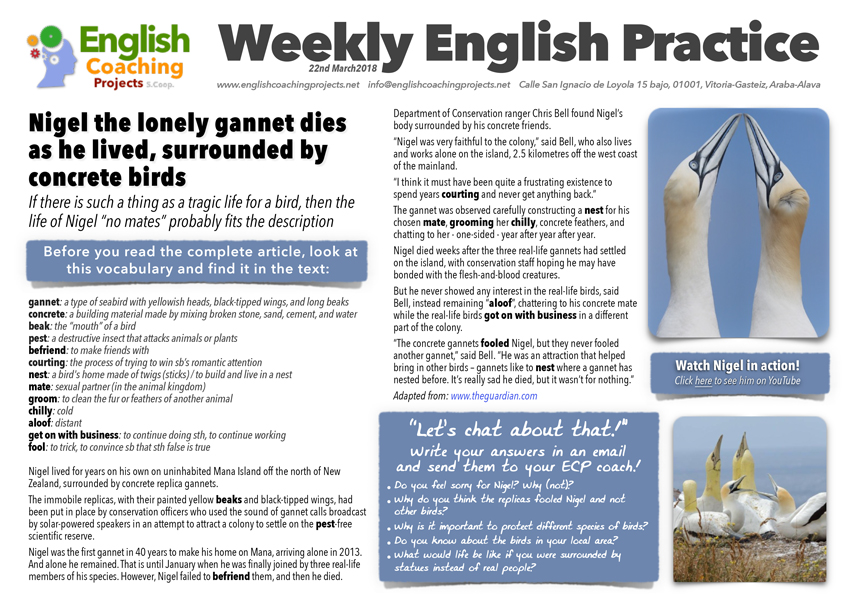Click on the image to download the pdf
If there is such a thing as a tragic life for a bird, then the life of Nigel “no mates” probably fits the description. He lived and died alone, surrounded by concrete birds.
Before you read the complete article, look at this vocabulary and find it in the text:
gannet: a type of seabird with yellowish heads, black-tipped wings, and long beaks
concrete: a building material made by mixing broken stone, sand, cement, and water
beak: the “mouth” of a bird
pest: a destructive insect that attacks animals or plants
befriend: to make friends with
courting: the process of trying to win sb’s romantic attention
nest: a bird’s home made of twigs (sticks) / to build and live in a nest
mate: sexual partner (in the animal kingdom)
groom: to clean the fur or feathers of another animal
chilly: cold
aloof: distant
get on with business: to continue doing sth, to continue working
fool: to trick, to convince sb that sth false is true
Nigel lived for years on his own on uninhabited Mana Island off the north of New Zealand, surrounded by concrete replica gannets.
The immobile replicas, with their painted yellow beaks and black-tipped wings, had been put in place by conservation officers who used the sound of gannet calls broadcast by solar-powered speakers in an attempt to attract a colony to settle on the pest-free scientific reserve.
Nigel was the first gannet in 40 years to make his home on Mana, arriving alone in 2013. And alone he remained. That is until January when he was finally joined by three real-life members of his species. However, Nigel failed to befriend them, and then he died.
Department of Conservation ranger Chris Bell found Nigel’s body surrounded by his concrete friends.
“Nigel was very faithful to the colony,” said Bell, who also lives and works alone on the island, 2.5 kilometres off the west coast of the mainland.
“I think it must have been quite a frustrating existence to spend years courting and never get anything back.”
The gannet was observed carefully constructing a nest for his chosen mate, grooming her chilly, concrete feathers, and chatting to her – one-sided – year after year after year.
Nigel died weeks after the three real-life gannets had settled on the island, with conservation staff hoping he may have bonded with the flesh-and-blood creatures.
But he never showed any interest in the real-life birds, said Bell, instead remaining “aloof”, chattering to his concrete mate while the real-life birds got on with business in a different part of the colony.
“The concrete gannets fooled Nigel, but they never fooled another gannet,” said Bell. “He was an attraction that helped bring in other birds – gannets like to nest where a gannet has nested before. It’s really sad he died, but it wasn’t for nothing.”
“Let’s chat about that!”
Write your answers in an email and send them to your ECP coach!
- Do you feel sorry for Nigel? Why (not)?
- Why do you think the replicas fooled Nigel and not other birds?
- Why is it important to protect different species of birds?
- Do you know about the birds in your local area?
- What would life be like if you were surrounded by statues instead of real people?
Adapted from: www.theguardian.com


